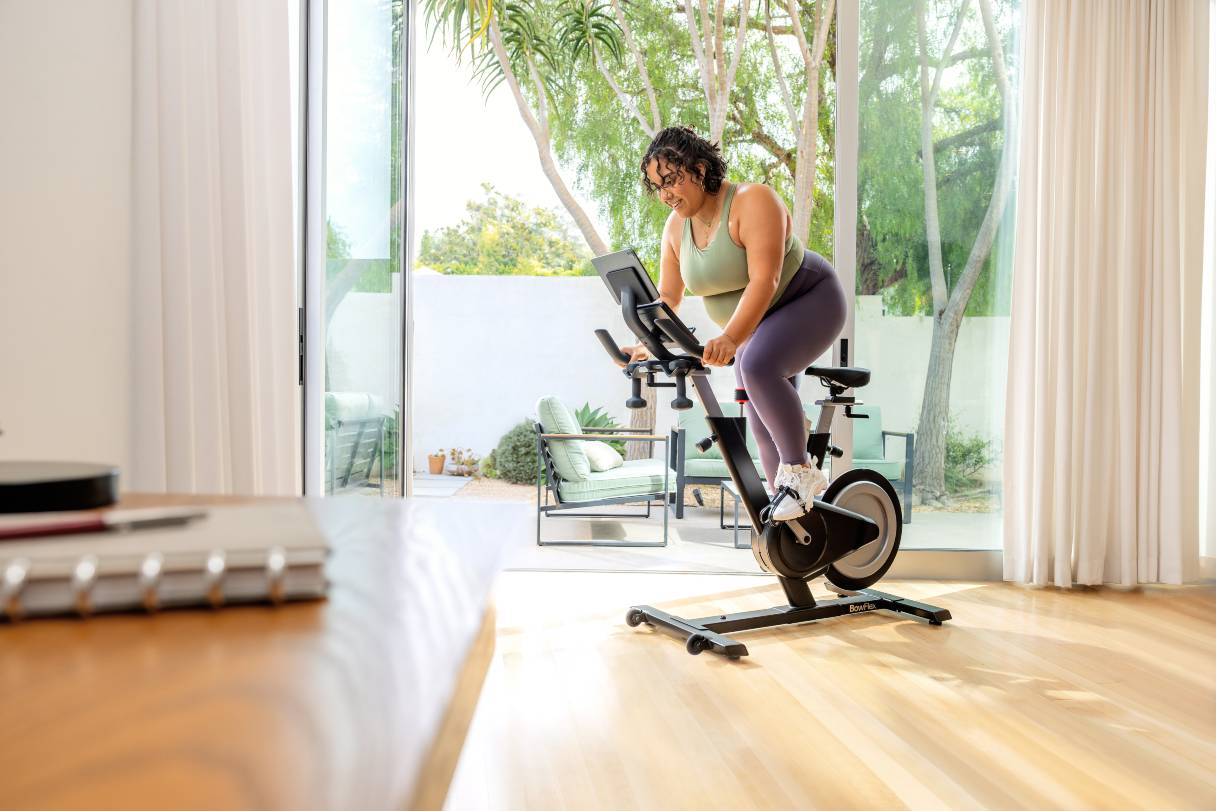We know regular exercise is one key component to maintaining our overall health, and that even modest amounts of weekly physical activity can improve our physical and emotional well-being. So why is it hard for so many of us to get into a move-groove and make exercise a habit?
You might blame yourself, thinking that the struggle to stick to a fitness routine can be chalked up to laziness or a lack of discipline. However, some experts suggest that good habit formation is challenging because, unlike bad habits, good habits don't often provide immediate gratification or reinforcement. In other words, we're biologically predisposed to choose the behavior that immediately fulfills our biological, social or emotional needs in the moment.1
The good news is that we humans have the brain power to influence our neural pathways. By creating immediate positive reinforcement for behaviors we want to encourage — like regular exercise — we're more likely to stick with a habit that might normally take much longer to feel rewarding.1
Read Related Articles
9 Winter Workout Tips To Keep You Motivated and Active
At-Home Workouts: Home Gym Ideas and Tips
Read on for 10 tips on how you might introduce both external and internal factors to get — and keep — your fitness routine on track.
1. Banish All-or-Nothing Thinking
Some movement is better than no movement, and even small amounts of exercise can have a big impact on your physical, mental and emotional well-being. Get rid of the idea that you need to spend hours doing an activity in order for it to be beneficial. When life happens and your workout plans get derailed, 10 minutes of yoga stretches in the middle of the day or a 15-minute walk outside might be all you can fit into your schedule — and that's OK.2
2. Know Your "Why"
“Get healthy" or “lose weight" sound like good reasons to exercise, but goals that are vague or undefined are unlikely to keep you motivated in the long term. A better approach might be to reframe exercise and movement in a way that highlights the positive outcomes that are meaningful to you.3
Expand your spectrum of reasons for staying active to include a better overall quality of life. Increased energy and reduced fatigue, for example, may allow you to do the things you love with greater enjoyment. Reduced stress, anxiety and depression benefits not only you but your relationships that matter the most. Feeling centered and strong helps you focus on projects and tasks that are important to you.3
3. Set Goals That Are Right for You
"Rome wasn't built in a day," as they say, so don't expect to fully master your fitness goals overnight; it's a process. The best place to start is where you are, no matter your current level of fitness. Your long-term goal might be to hike a major mountain, but for now, set smaller goals you know you can achieve. For example, you might aim for 15 to 20 minutes of daily walking, add a yoga class to your week or sign up for an eight-week exercise class. Once you've reached your small goal, reward yourself and set a new one.4
4. Choose Activities That Make You Happy
No amount of determination will make you stick long term with an activity you hate. Treadmills and spin classes are great but are effective only if you use them regularly.
Your options are almost limitless when it comes to finding movement that feels good to you. Running or walking outside may be your thing, or biking or swimming. You might consider a new-to-you activity that engages you both mentally and physically, such as:2
- Hiking
- Paddle sports: kayaking, canoeing, paddleboarding
- Rock climbing
- Dancing: ballroom, ballet, hip-hop, jazz, salsa
- Martial arts
- Circus skills (really!)
- Pickleball
- Yoga
- Rollerblading
- Volleyball
- Horseback riding
- Boxing
- Zumba
- Fencing
Be willing to experiment with different types of movement to find what suits you. Ideally, you'll find more than one form of exercise you enjoy, allowing you to mix it up and keep things interesting. You're more likely to pursue activities you find to be fun, engrossing and that boost your self-confidence. Feel free to pass on activities you find boring, intimidating or just not a good fit.2
5. Pair Exercise With Something Enjoyable
We don't usually need convincing to do something we already like to do, so link your exercise to things you find pleasurable. If bingeing a favorite podcast, TV show or audiobook during your workout is what gets you walking, running, lifting or stretching, by all means, go for it.3
Some people give themselves permission to enjoy entertainment they'd normally consider a “guilty pleasure" as a reward for exercise. That said, consider removing the word “guilt" from anything exercise-related and your workout becomes something associated with just plain pleasure.
6. Use Rewards
Reward yourself in healthy ways to reinforce the behaviors you want to repeat. In the beginning it might be a small reward every time you complete a workout, like a favorite snack or beverage, a power nap, adding new music to your playlist or spending extra time with your favorite people.5 Whatever it is, make it something you'll look forward to.
As you progress, consider raising the bar to earn your rewards. You might even pay yourself to exercise and earmark the money for a bigger reward when you hit a milestone. Whether you keep track of your deposits with an app, a money jar or pen and paper, keep your eye on the prize and watch your funds grow.5
7. Be Social
Scheduling workout time with a spouse, other family or friends not only makes exercise a social event, but you're more likely to hold yourself accountable when you know others are counting on you to show up. You can also join an existing workout group or club and connect with others who have interests similar to yours.2
Group classes are a good option if you prefer a noncompetitive atmosphere. If friendly competition keeps you motivated, adult team sports like basketball, soccer, softball or tennis could be good for you.2
8. Schedule It
Block time on your calendar just as you would for other appointments. Set reminders on your phone or smart assistant or use sticky notes so you don't forget. It's important to honor that time and not allow meeting requests or other appointments to preempt your workout.4
You can also set visual cues for yourself, like leaving your running shoes near the door or a gym bag on the front seat of your car.2 If a scheduled workout feels like a chore, reframe your mindset to think of it as a gift to yourself to not only move your body in a way that feels good but time to think, daydream, plan, get lost in your favorite music, recharge and just be with your body.
Above all, make it convenient.4 If your mornings are already hectic enough, can you exercise at lunch? How about on the way home from work? Can you use the time your child has their extracurricular activity to go for a run or walk before picking them up? Try to think of as many ways as you can to fit even small amounts of exercise in so you have plenty of options on busy days.
9. Get a Dog
There's no question that a four-legged family member who needs daily exercise, rain or shine, is a surefire way to get more movement into your routine. Walking, running or playing with a dog not only has physical benefits but provides opportunity for emotional connection as well.2
If you're not able to own a dog, consider volunteering to walk dogs at your local animal shelter. You'll be helping exercise and socialize a new furry friend, which makes them more adoptable, while you both reap the benefits of movement.2
10. Practice Patience and Self-Compassion
It often takes weeks — even months — to establish a new habit, and even once established there will be ups and downs, stops and restarts because life happens.
You'll make more effective, lasting changes when you practice self-compassion and treat yourself with kindness rather than criticism. If you do miss a goal or fall off the wagon, recognize that it's not the end of the world, and you always have the opportunity to make a fresh start. Ask yourself how you would talk to a friend if they turned to you for empathy, and use the same type of self-talk to support your own goals.3
Managing Health & Wellness Costs With the CareCredit Credit Card
If you are looking for an option to help manage your health & wellness costs, consider financing with the CareCredit credit card. The CareCredit credit card can help you pay for the care you want and need and make payments easy to manage.* Use our Acceptance Locator to find a provider near you that accepts CareCredit. Continue your wellness journey by downloading the CareCredit Mobile App to manage your account, find a provider on the go and easily access the Well U blog for more great articles, podcasts and videos.
Your CareCredit credit card can be used in so many ways within the CareCredit network including vision, dentistry, cosmetic, pet care, hearing, health systems, dermatology, pharmacy purchases and spa treatments. How will you invest in your health and wellness next?
Author Bio
Anne-Marie Kennedy is a freelance writer with more than 20 years of experience covering health and wellness, personal finance and real estate/investing.








